Examining Pliny the Elder's Botanical Legacy in Natural History
VerifiedAdded on 2023/06/03
|8
|1668
|488
Essay
AI Summary
This essay examines Pliny the Elder's contributions to botany, focusing on his renowned work, Natural History. It delves into his life, education, and significant accomplishments related to plants, highlighting his influence from Theophrastus and his independent observations of various plant species. The essay discusses Pliny's insights into Roman gardens, agricultural techniques, and the medicinal uses of plants, as well as his experiments with herbs and trees. It also covers his findings on exotic trees, vine production, and the importance of olive oil, emphasizing his lasting impact on botanical knowledge and its practical applications. Desklib offers a variety of study tools and resources, including solved assignments and past papers, to support students in their academic endeavors.

Running head: PLINY THE ELDER AS BOTANIST
PLINY THE ELDER AS BOTANIST
Name of the student:
Name of the University:
Author's Note:
PLINY THE ELDER AS BOTANIST
Name of the student:
Name of the University:
Author's Note:
Paraphrase This Document
Need a fresh take? Get an instant paraphrase of this document with our AI Paraphraser

1PLINY THE ELDER AS BOTANIST
The Renaissance commentators of late fifteenth and sixteenth centuries, have
rediscovered the ancient botany and produced editions of some of the most famous ancient
botanists such as Theophrastus, Dioscorides, Galen and Pliny the Elder. The aim of this paper is
to discover the contribution of Pliny the Elder in the world of botany. Pliny the Elder who is also
known as Gaius Plinius Secundus was born in 23 CE, in the town of Novum Comum and died in
August 24. He was the most famous for his most celebrated work on botany namely Natural
History. This is an encyclopedic work with an uneven accuracy defining the authority on
scientific matters (Tomlinson). This book by Pliny the Elder was followed till the middle ages.
This essay will cover the life of Pliny the Elder including his Education, accomplishment relating
plants, experiments and other notable accomplishment.
Figure 1. Pliny the Elder
(Source: Laphamsquarterly.org)
The Renaissance commentators of late fifteenth and sixteenth centuries, have
rediscovered the ancient botany and produced editions of some of the most famous ancient
botanists such as Theophrastus, Dioscorides, Galen and Pliny the Elder. The aim of this paper is
to discover the contribution of Pliny the Elder in the world of botany. Pliny the Elder who is also
known as Gaius Plinius Secundus was born in 23 CE, in the town of Novum Comum and died in
August 24. He was the most famous for his most celebrated work on botany namely Natural
History. This is an encyclopedic work with an uneven accuracy defining the authority on
scientific matters (Tomlinson). This book by Pliny the Elder was followed till the middle ages.
This essay will cover the life of Pliny the Elder including his Education, accomplishment relating
plants, experiments and other notable accomplishment.
Figure 1. Pliny the Elder
(Source: Laphamsquarterly.org)
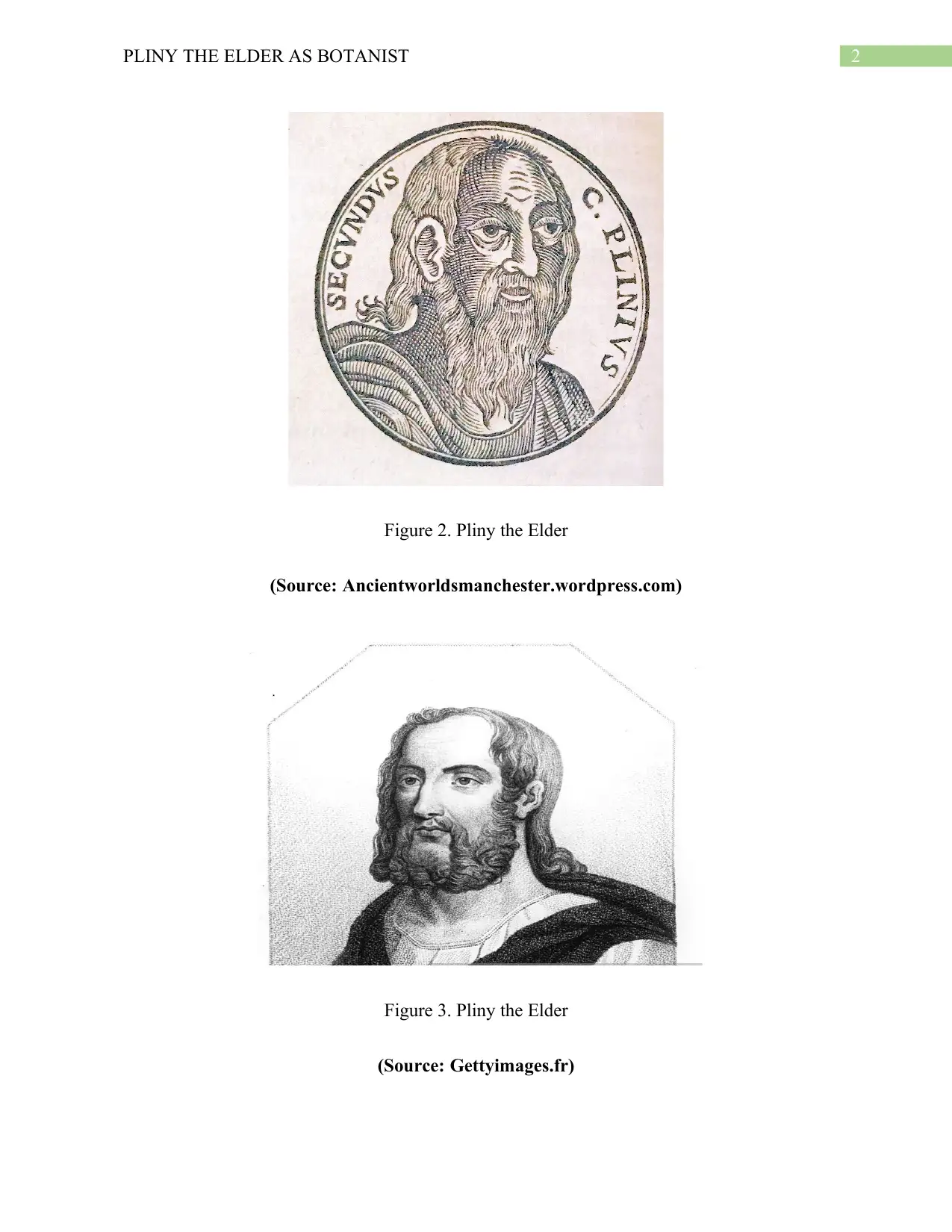
2PLINY THE ELDER AS BOTANIST
Figure 2. Pliny the Elder
(Source: Ancientworldsmanchester.wordpress.com)
Figure 3. Pliny the Elder
(Source: Gettyimages.fr)
Figure 2. Pliny the Elder
(Source: Ancientworldsmanchester.wordpress.com)
Figure 3. Pliny the Elder
(Source: Gettyimages.fr)
⊘ This is a preview!⊘
Do you want full access?
Subscribe today to unlock all pages.

Trusted by 1+ million students worldwide
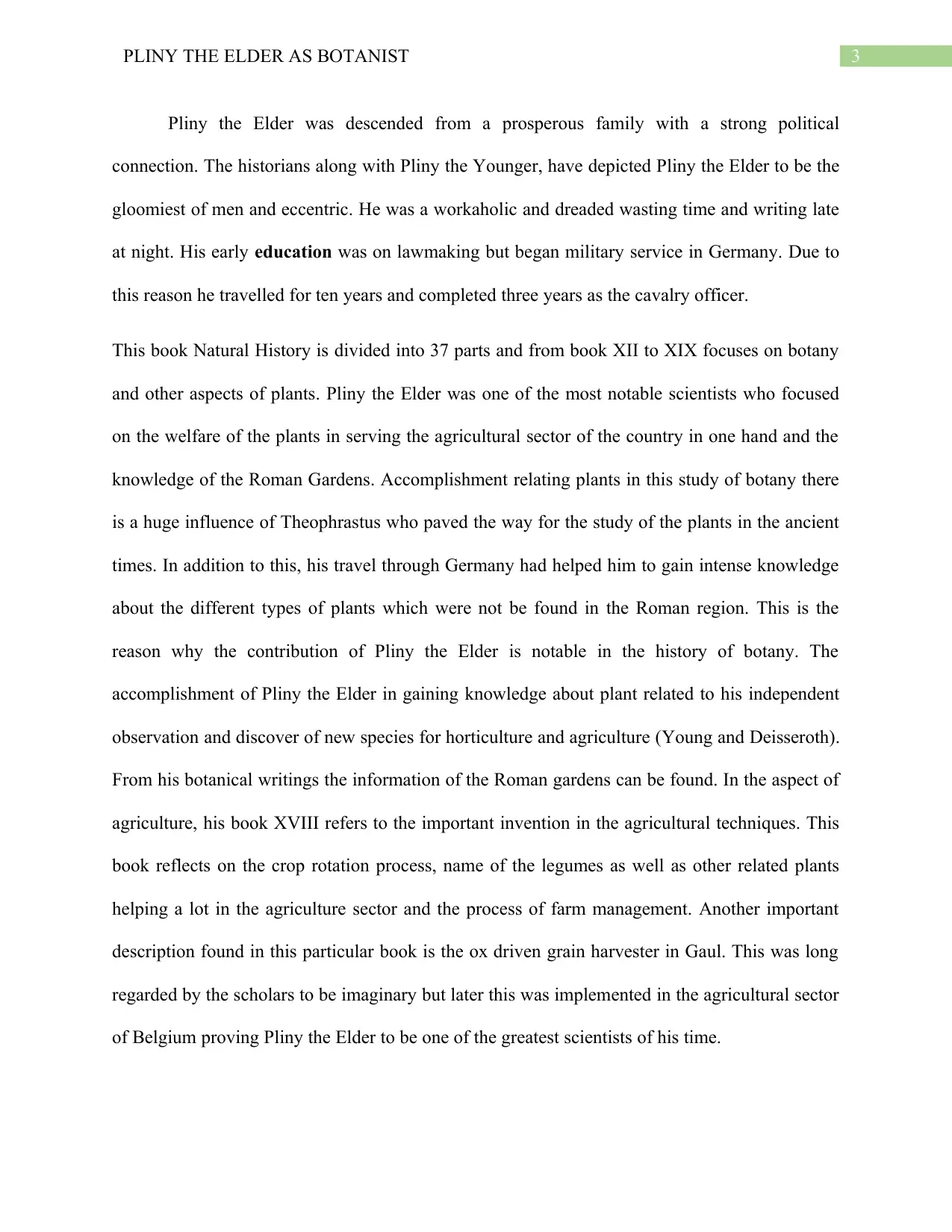
3PLINY THE ELDER AS BOTANIST
Pliny the Elder was descended from a prosperous family with a strong political
connection. The historians along with Pliny the Younger, have depicted Pliny the Elder to be the
gloomiest of men and eccentric. He was a workaholic and dreaded wasting time and writing late
at night. His early education was on lawmaking but began military service in Germany. Due to
this reason he travelled for ten years and completed three years as the cavalry officer.
This book Natural History is divided into 37 parts and from book XII to XIX focuses on botany
and other aspects of plants. Pliny the Elder was one of the most notable scientists who focused
on the welfare of the plants in serving the agricultural sector of the country in one hand and the
knowledge of the Roman Gardens. Accomplishment relating plants in this study of botany there
is a huge influence of Theophrastus who paved the way for the study of the plants in the ancient
times. In addition to this, his travel through Germany had helped him to gain intense knowledge
about the different types of plants which were not be found in the Roman region. This is the
reason why the contribution of Pliny the Elder is notable in the history of botany. The
accomplishment of Pliny the Elder in gaining knowledge about plant related to his independent
observation and discover of new species for horticulture and agriculture (Young and Deisseroth).
From his botanical writings the information of the Roman gardens can be found. In the aspect of
agriculture, his book XVIII refers to the important invention in the agricultural techniques. This
book reflects on the crop rotation process, name of the legumes as well as other related plants
helping a lot in the agriculture sector and the process of farm management. Another important
description found in this particular book is the ox driven grain harvester in Gaul. This was long
regarded by the scholars to be imaginary but later this was implemented in the agricultural sector
of Belgium proving Pliny the Elder to be one of the greatest scientists of his time.
Pliny the Elder was descended from a prosperous family with a strong political
connection. The historians along with Pliny the Younger, have depicted Pliny the Elder to be the
gloomiest of men and eccentric. He was a workaholic and dreaded wasting time and writing late
at night. His early education was on lawmaking but began military service in Germany. Due to
this reason he travelled for ten years and completed three years as the cavalry officer.
This book Natural History is divided into 37 parts and from book XII to XIX focuses on botany
and other aspects of plants. Pliny the Elder was one of the most notable scientists who focused
on the welfare of the plants in serving the agricultural sector of the country in one hand and the
knowledge of the Roman Gardens. Accomplishment relating plants in this study of botany there
is a huge influence of Theophrastus who paved the way for the study of the plants in the ancient
times. In addition to this, his travel through Germany had helped him to gain intense knowledge
about the different types of plants which were not be found in the Roman region. This is the
reason why the contribution of Pliny the Elder is notable in the history of botany. The
accomplishment of Pliny the Elder in gaining knowledge about plant related to his independent
observation and discover of new species for horticulture and agriculture (Young and Deisseroth).
From his botanical writings the information of the Roman gardens can be found. In the aspect of
agriculture, his book XVIII refers to the important invention in the agricultural techniques. This
book reflects on the crop rotation process, name of the legumes as well as other related plants
helping a lot in the agriculture sector and the process of farm management. Another important
description found in this particular book is the ox driven grain harvester in Gaul. This was long
regarded by the scholars to be imaginary but later this was implemented in the agricultural sector
of Belgium proving Pliny the Elder to be one of the greatest scientists of his time.
Paraphrase This Document
Need a fresh take? Get an instant paraphrase of this document with our AI Paraphraser
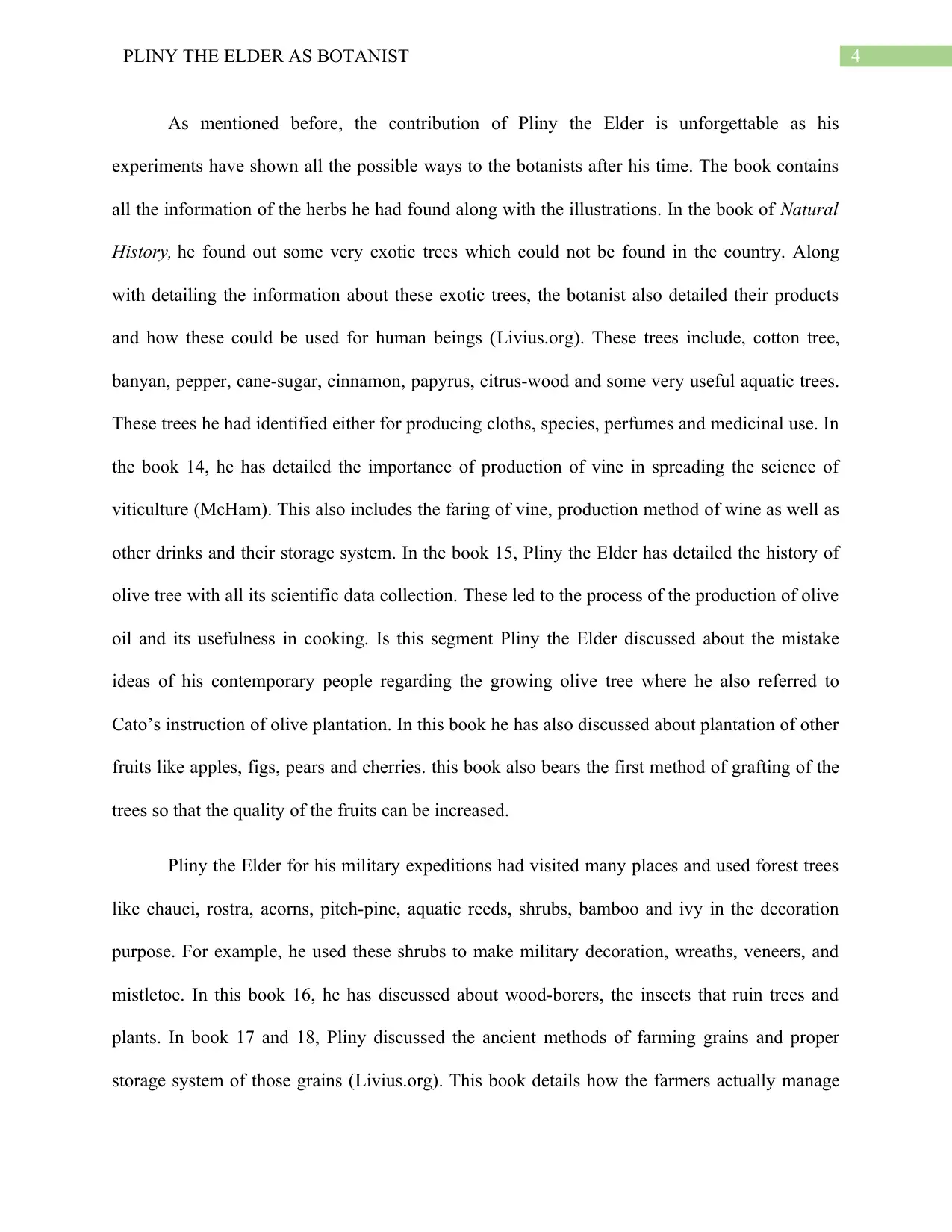
4PLINY THE ELDER AS BOTANIST
As mentioned before, the contribution of Pliny the Elder is unforgettable as his
experiments have shown all the possible ways to the botanists after his time. The book contains
all the information of the herbs he had found along with the illustrations. In the book of Natural
History, he found out some very exotic trees which could not be found in the country. Along
with detailing the information about these exotic trees, the botanist also detailed their products
and how these could be used for human beings (Livius.org). These trees include, cotton tree,
banyan, pepper, cane-sugar, cinnamon, papyrus, citrus-wood and some very useful aquatic trees.
These trees he had identified either for producing cloths, species, perfumes and medicinal use. In
the book 14, he has detailed the importance of production of vine in spreading the science of
viticulture (McHam). This also includes the faring of vine, production method of wine as well as
other drinks and their storage system. In the book 15, Pliny the Elder has detailed the history of
olive tree with all its scientific data collection. These led to the process of the production of olive
oil and its usefulness in cooking. Is this segment Pliny the Elder discussed about the mistake
ideas of his contemporary people regarding the growing olive tree where he also referred to
Cato’s instruction of olive plantation. In this book he has also discussed about plantation of other
fruits like apples, figs, pears and cherries. this book also bears the first method of grafting of the
trees so that the quality of the fruits can be increased.
Pliny the Elder for his military expeditions had visited many places and used forest trees
like chauci, rostra, acorns, pitch-pine, aquatic reeds, shrubs, bamboo and ivy in the decoration
purpose. For example, he used these shrubs to make military decoration, wreaths, veneers, and
mistletoe. In this book 16, he has discussed about wood-borers, the insects that ruin trees and
plants. In book 17 and 18, Pliny discussed the ancient methods of farming grains and proper
storage system of those grains (Livius.org). This book details how the farmers actually manage
As mentioned before, the contribution of Pliny the Elder is unforgettable as his
experiments have shown all the possible ways to the botanists after his time. The book contains
all the information of the herbs he had found along with the illustrations. In the book of Natural
History, he found out some very exotic trees which could not be found in the country. Along
with detailing the information about these exotic trees, the botanist also detailed their products
and how these could be used for human beings (Livius.org). These trees include, cotton tree,
banyan, pepper, cane-sugar, cinnamon, papyrus, citrus-wood and some very useful aquatic trees.
These trees he had identified either for producing cloths, species, perfumes and medicinal use. In
the book 14, he has detailed the importance of production of vine in spreading the science of
viticulture (McHam). This also includes the faring of vine, production method of wine as well as
other drinks and their storage system. In the book 15, Pliny the Elder has detailed the history of
olive tree with all its scientific data collection. These led to the process of the production of olive
oil and its usefulness in cooking. Is this segment Pliny the Elder discussed about the mistake
ideas of his contemporary people regarding the growing olive tree where he also referred to
Cato’s instruction of olive plantation. In this book he has also discussed about plantation of other
fruits like apples, figs, pears and cherries. this book also bears the first method of grafting of the
trees so that the quality of the fruits can be increased.
Pliny the Elder for his military expeditions had visited many places and used forest trees
like chauci, rostra, acorns, pitch-pine, aquatic reeds, shrubs, bamboo and ivy in the decoration
purpose. For example, he used these shrubs to make military decoration, wreaths, veneers, and
mistletoe. In this book 16, he has discussed about wood-borers, the insects that ruin trees and
plants. In book 17 and 18, Pliny discussed the ancient methods of farming grains and proper
storage system of those grains (Livius.org). This book details how the farmers actually manage
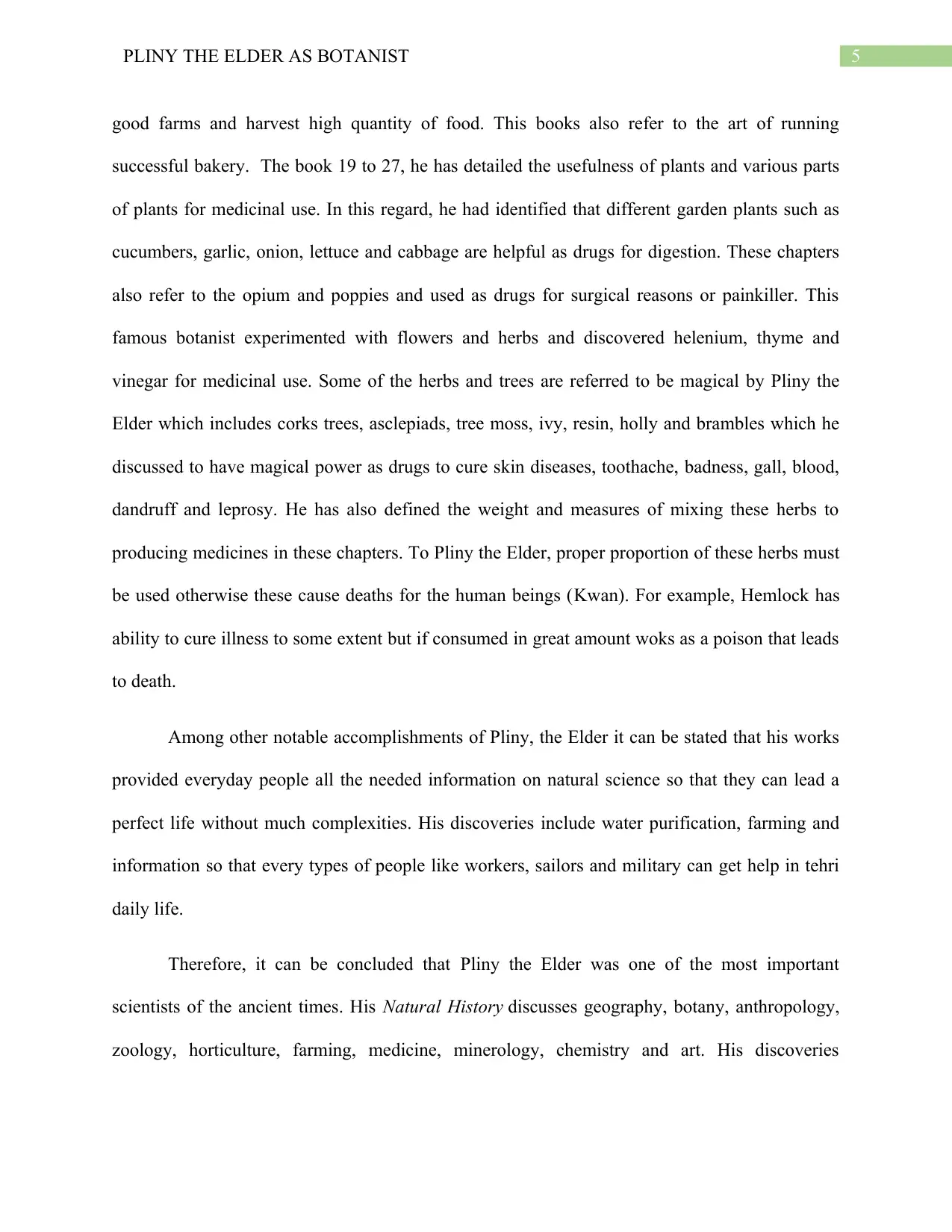
5PLINY THE ELDER AS BOTANIST
good farms and harvest high quantity of food. This books also refer to the art of running
successful bakery. The book 19 to 27, he has detailed the usefulness of plants and various parts
of plants for medicinal use. In this regard, he had identified that different garden plants such as
cucumbers, garlic, onion, lettuce and cabbage are helpful as drugs for digestion. These chapters
also refer to the opium and poppies and used as drugs for surgical reasons or painkiller. This
famous botanist experimented with flowers and herbs and discovered helenium, thyme and
vinegar for medicinal use. Some of the herbs and trees are referred to be magical by Pliny the
Elder which includes corks trees, asclepiads, tree moss, ivy, resin, holly and brambles which he
discussed to have magical power as drugs to cure skin diseases, toothache, badness, gall, blood,
dandruff and leprosy. He has also defined the weight and measures of mixing these herbs to
producing medicines in these chapters. To Pliny the Elder, proper proportion of these herbs must
be used otherwise these cause deaths for the human beings (Kwan). For example, Hemlock has
ability to cure illness to some extent but if consumed in great amount woks as a poison that leads
to death.
Among other notable accomplishments of Pliny, the Elder it can be stated that his works
provided everyday people all the needed information on natural science so that they can lead a
perfect life without much complexities. His discoveries include water purification, farming and
information so that every types of people like workers, sailors and military can get help in tehri
daily life.
Therefore, it can be concluded that Pliny the Elder was one of the most important
scientists of the ancient times. His Natural History discusses geography, botany, anthropology,
zoology, horticulture, farming, medicine, minerology, chemistry and art. His discoveries
good farms and harvest high quantity of food. This books also refer to the art of running
successful bakery. The book 19 to 27, he has detailed the usefulness of plants and various parts
of plants for medicinal use. In this regard, he had identified that different garden plants such as
cucumbers, garlic, onion, lettuce and cabbage are helpful as drugs for digestion. These chapters
also refer to the opium and poppies and used as drugs for surgical reasons or painkiller. This
famous botanist experimented with flowers and herbs and discovered helenium, thyme and
vinegar for medicinal use. Some of the herbs and trees are referred to be magical by Pliny the
Elder which includes corks trees, asclepiads, tree moss, ivy, resin, holly and brambles which he
discussed to have magical power as drugs to cure skin diseases, toothache, badness, gall, blood,
dandruff and leprosy. He has also defined the weight and measures of mixing these herbs to
producing medicines in these chapters. To Pliny the Elder, proper proportion of these herbs must
be used otherwise these cause deaths for the human beings (Kwan). For example, Hemlock has
ability to cure illness to some extent but if consumed in great amount woks as a poison that leads
to death.
Among other notable accomplishments of Pliny, the Elder it can be stated that his works
provided everyday people all the needed information on natural science so that they can lead a
perfect life without much complexities. His discoveries include water purification, farming and
information so that every types of people like workers, sailors and military can get help in tehri
daily life.
Therefore, it can be concluded that Pliny the Elder was one of the most important
scientists of the ancient times. His Natural History discusses geography, botany, anthropology,
zoology, horticulture, farming, medicine, minerology, chemistry and art. His discoveries
⊘ This is a preview!⊘
Do you want full access?
Subscribe today to unlock all pages.

Trusted by 1+ million students worldwide
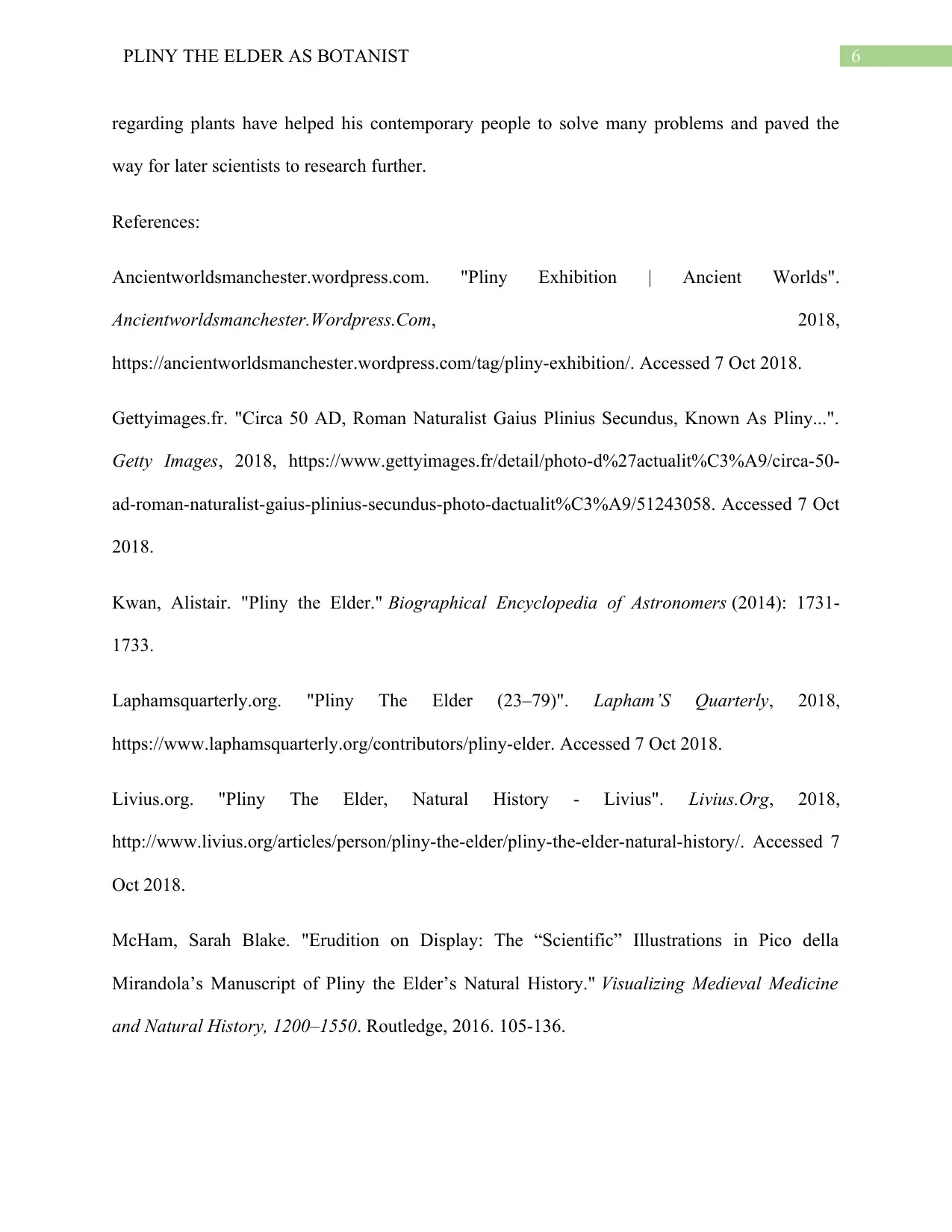
6PLINY THE ELDER AS BOTANIST
regarding plants have helped his contemporary people to solve many problems and paved the
way for later scientists to research further.
References:
Ancientworldsmanchester.wordpress.com. "Pliny Exhibition | Ancient Worlds".
Ancientworldsmanchester.Wordpress.Com, 2018,
https://ancientworldsmanchester.wordpress.com/tag/pliny-exhibition/. Accessed 7 Oct 2018.
Gettyimages.fr. "Circa 50 AD, Roman Naturalist Gaius Plinius Secundus, Known As Pliny...".
Getty Images, 2018, https://www.gettyimages.fr/detail/photo-d%27actualit%C3%A9/circa-50-
ad-roman-naturalist-gaius-plinius-secundus-photo-dactualit%C3%A9/51243058. Accessed 7 Oct
2018.
Kwan, Alistair. "Pliny the Elder." Biographical Encyclopedia of Astronomers (2014): 1731-
1733.
Laphamsquarterly.org. "Pliny The Elder (23–79)". Lapham’S Quarterly, 2018,
https://www.laphamsquarterly.org/contributors/pliny-elder. Accessed 7 Oct 2018.
Livius.org. "Pliny The Elder, Natural History - Livius". Livius.Org, 2018,
http://www.livius.org/articles/person/pliny-the-elder/pliny-the-elder-natural-history/. Accessed 7
Oct 2018.
McHam, Sarah Blake. "Erudition on Display: The “Scientific” Illustrations in Pico della
Mirandola’s Manuscript of Pliny the Elder’s Natural History." Visualizing Medieval Medicine
and Natural History, 1200–1550. Routledge, 2016. 105-136.
regarding plants have helped his contemporary people to solve many problems and paved the
way for later scientists to research further.
References:
Ancientworldsmanchester.wordpress.com. "Pliny Exhibition | Ancient Worlds".
Ancientworldsmanchester.Wordpress.Com, 2018,
https://ancientworldsmanchester.wordpress.com/tag/pliny-exhibition/. Accessed 7 Oct 2018.
Gettyimages.fr. "Circa 50 AD, Roman Naturalist Gaius Plinius Secundus, Known As Pliny...".
Getty Images, 2018, https://www.gettyimages.fr/detail/photo-d%27actualit%C3%A9/circa-50-
ad-roman-naturalist-gaius-plinius-secundus-photo-dactualit%C3%A9/51243058. Accessed 7 Oct
2018.
Kwan, Alistair. "Pliny the Elder." Biographical Encyclopedia of Astronomers (2014): 1731-
1733.
Laphamsquarterly.org. "Pliny The Elder (23–79)". Lapham’S Quarterly, 2018,
https://www.laphamsquarterly.org/contributors/pliny-elder. Accessed 7 Oct 2018.
Livius.org. "Pliny The Elder, Natural History - Livius". Livius.Org, 2018,
http://www.livius.org/articles/person/pliny-the-elder/pliny-the-elder-natural-history/. Accessed 7
Oct 2018.
McHam, Sarah Blake. "Erudition on Display: The “Scientific” Illustrations in Pico della
Mirandola’s Manuscript of Pliny the Elder’s Natural History." Visualizing Medieval Medicine
and Natural History, 1200–1550. Routledge, 2016. 105-136.
Paraphrase This Document
Need a fresh take? Get an instant paraphrase of this document with our AI Paraphraser

7PLINY THE ELDER AS BOTANIST
Tomlinson, Rowan. "Anecdote, Example, Method: Renaissance Accounts of the Death of Pliny
the Elder." Method and Variation. Routledge, 2017. 23-40.
Young, Noah P., and Karl Deisseroth. "Cognitive neuroscience: in search of lost
time." Nature 542.7640 (2017): 173.
Tomlinson, Rowan. "Anecdote, Example, Method: Renaissance Accounts of the Death of Pliny
the Elder." Method and Variation. Routledge, 2017. 23-40.
Young, Noah P., and Karl Deisseroth. "Cognitive neuroscience: in search of lost
time." Nature 542.7640 (2017): 173.
1 out of 8
Your All-in-One AI-Powered Toolkit for Academic Success.
+13062052269
info@desklib.com
Available 24*7 on WhatsApp / Email
![[object Object]](/_next/static/media/star-bottom.7253800d.svg)
Unlock your academic potential
Copyright © 2020–2025 A2Z Services. All Rights Reserved. Developed and managed by ZUCOL.
